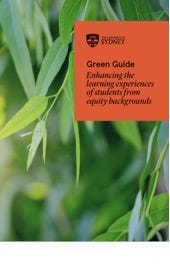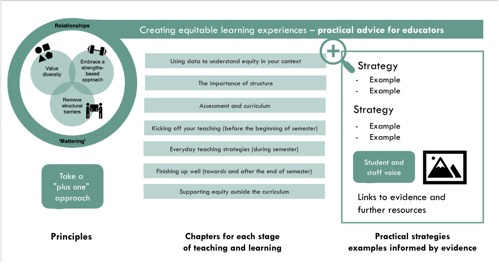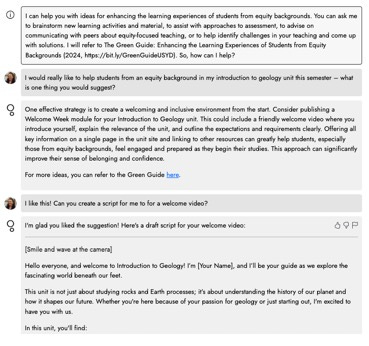Beyond Access: Why Australia's Equity Challenge Requires Practical Teaching Solutions
Samantha Clarke, Jessica Frawley and Eszter Kalman, The University of Sydney
In the wake of the Universities Accord, Australian higher education faces a critical juncture. The Accord highlighted significant disparities in access, participation and success for students from equity backgrounds and called for meaningful action. While the sector debates large-scale reforms, a more immediate question needs to be asked (and answered): What can educators do now to support the diverse students already in their classrooms?
The gap between policy and practice
Australian higher education has become adept at identifying equity problems and developing policy responses. We know that students from historically underrepresented groups face systemic barriers from enrolment through to completion. We understand that quality teaching matters for learning, engagement, belonging, retention and success. Yet many educators still struggle to translate these insights into everyday practice, either because they sit within policy and institutional scope or because they exist within research silos that require translation for easy uptake.
Many educators feel overwhelmed when trying to translate equity principles into everyday teaching practice – we need concrete strategies, not just good intentions or positive policy.
This is where practical resources become crucial. Tools that help educators implement evidence-based equity practices without requiring institutional overhaul, bridging the gap between knowing what should be done and actually doing it.
Small changes, systemic impact
While structural reform remains essential, the reality is that much equity work currently falls to individual educators operating within existing constraints. Research consistently shows that seemingly small pedagogical changes – clearer communication, flexible and inclusive assessment options, strengths-based feedback – can significantly impact student experiences and outcomes.
These micro-level interventions become even more important given the Accord's projection of substantial growth in student participation. As Emeritus Professor Denise Chalmers notes, we cannot meaningfully expand access, and close well-known completion gaps without addressing the quality of teaching these students will receive.
Sonal Singh from UTS similarly emphasises that we must do more, now more than ever: genuine reform requires embedding equity throughout "university planning, curriculum design, and student services". For individual educators, this means moving beyond awareness to implementation – developing practical skills for creating equitable learning environments.
A practical guide for all educators
Enter the Green Guide – a practical, evidence-based resource developed collaboratively by educators and students at the University of Sydney. This open-access Guide offers practical and actionable techniques that any educator can use to enhance learning experiences for students from diverse backgrounds, helping educators make the most of the richness that exists within their classrooms to effectively support and empower all students' learning.
The Guide is grounded in four key evidence-based principles, chosen to address the most critical factors that research shows impact equity student success:
Valuing diversity - creating inclusive environments where all students feel valued through teaching strategies that reflect varied cultural and social perspectives, enriching the learning environment for everyone while challenging stereotypes.
Embracing a strengths-based approach - recognising and leveraging the unique abilities and assets that students from equity backgrounds bring to the classroom, fostering belonging and academic success rather than focusing on perceived deficits.
Removing structural barriers to academic success - identifying and eliminating barriers within educational structures, policies, and practices that hinder equity students' opportunities to succeed.
Grounding all interactions with students in relationships and 'mattering' - building meaningful relationships where students feel valued and cared for, creating supportive environments where both contributions and well-being are seen as genuinely important to their teachers.
The Guide is structured around the teaching and learning cycle, taking educators from initial student considerations and learning design, through the teaching semester, and on to supporting students beyond the formal curriculum. Each chapter offers evidence-based strategies with practical examples, illustrated by student and staff perspectives, plus templates and links to further resources. Rather than requiring wholesale change, the Guide encourages educators to try the "+1 approach" – implementing one new strategy each semester to gradually build their equity-focused teaching toolkit, recognising that small changes can have significant impact.
The Green Guide explainer
The Green Guide bridges the gap between equity research and teaching practice through principles, strategies and exemplars that illustrate how equity-focussed teaching can come to life. The Guide itself embodies its own principles through the inclusion of student and staff voices throughout.
So, how might a teaching academic use this resource? For example, someone looking to improve assessment can find a short four-page chapter that provides evidence-informed equity perspectives on curriculum design, supporting assessment and providing feedback. The chapter addresses overlooked barriers, such as the assumption that students understand feedback processes, and illustrates with specific examples how educators can make these processes more transparent and explicit. The Guide frames feedback as "more than just a mark", which is particularly important for students from equity backgrounds who may question whether they belong at university.
As another example, educators looking to support student resilience can use the Guide's section on reframing struggle. Rather than viewing difficulty as failure, the Guide shows how to help students shift their mindset from "I'm falling behind" to "this is difficult and requires more effort". It provides actionable strategies for normalising challenge while maintaining high expectations, helping students understand that difficulty is inherent to the knowledge being learned, not a personal fault.
Extending accessibility through technology
To further support busy educators in implementing these strategies, the Green Guide includes a generative AI companion that helps translate the Guide's principles into discipline-specific applications. Rather than replacing pedagogical expertise, this tool acts as a knowledge broker, helping educators create tailored activities, communication templates, and assessment tasks that embody the Guide's equity principles.
An example of the Green Guide AI agent helping educators brainstorm and create equity-focused learning materials
A call for practical solutions
The Universities Accord provides a framework for transformation, but achieving its equity ambitions requires concrete, evidence-based tools that educators feel empowered to use immediately. The question isn't whether we need systemic change – we do. The question is what we can implement now as we collectively work toward that larger transformation, moving from knowing what should be done to actually doing it.
Dr Samantha Clarke, Dr Jessica Frawley, and Dr Eszter Kalman are Senior Lecturers in the DVC Education Portfolio at the University of Sydney and co-authors of the Green Guide.





